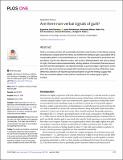Files in this item
Are there non-verbal signals of guilt?
Item metadata
| dc.contributor.author | Julle-Danière, Eglantine | |
| dc.contributor.author | Whitehouse, Jamie | |
| dc.contributor.author | Mielke, Alexander | |
| dc.contributor.author | Vrij, Aldert | |
| dc.contributor.author | Gustafsson, Erik | |
| dc.contributor.author | Micheletta, Jérôme | |
| dc.contributor.author | Waller, Bridget M. | |
| dc.date.accessioned | 2021-12-01T11:30:15Z | |
| dc.date.available | 2021-12-01T11:30:15Z | |
| dc.date.issued | 2020-04-24 | |
| dc.identifier | 276614398 | |
| dc.identifier | ccd5b3c7-823c-487f-af4d-d401279734f7 | |
| dc.identifier | 85083722403 | |
| dc.identifier | 32330158 | |
| dc.identifier.citation | Julle-Danière , E , Whitehouse , J , Mielke , A , Vrij , A , Gustafsson , E , Micheletta , J & Waller , B M 2020 , ' Are there non-verbal signals of guilt? ' , PLoS ONE , vol. 15 , no. 4 , e0231756 . https://doi.org/10.1371/journal.pone.0231756 | en |
| dc.identifier.issn | 1932-6203 | |
| dc.identifier.other | Bibtex: julle2020there | |
| dc.identifier.uri | https://hdl.handle.net/10023/24449 | |
| dc.description | The studies were funded by a Leverhulme Trust Research Project Grant Cultural variation in the social function and expression of guilt awarded to the seventh and fourth authors (RPG-2016-206) and the Leverhulme Trust Research Project Grant Rethinking complexity in facial communication systems awarded to the sixth author (RPG-2018-334). | en |
| dc.description.abstract | Guilt is a complex emotion with a potentially important social function of stimulating cooperative behaviours towards and from others, but whether the feeling of guilt is associated with a recognisable pattern of nonverbal behaviour is unknown. We examined the production and perception of guilt in two different studies, with a total of 238 participants with various places of origin. Guilt was induced experimentally, eliciting patterns of movement that were associated with both the participants’ self-reported feelings of guilt and judges’ impressions of their guilt. Guilt was most closely associated with frowning and neck touching. While there were differences between self-reported guilt and perception of guilt the findings suggest that there are consistent patterns that could be considered a non-verbal signal of guilt in humans. | |
| dc.format.extent | 1159783 | |
| dc.language.iso | eng | |
| dc.relation.ispartof | PLoS ONE | en |
| dc.subject | BF Psychology | en |
| dc.subject | RC0321 Neuroscience. Biological psychiatry. Neuropsychiatry | en |
| dc.subject | DAS | en |
| dc.subject.lcc | BF | en |
| dc.subject.lcc | RC0321 | en |
| dc.title | Are there non-verbal signals of guilt? | en |
| dc.type | Journal article | en |
| dc.contributor.institution | University of St Andrews. School of Psychology and Neuroscience | en |
| dc.identifier.doi | https://doi.org/10.1371/journal.pone.0231756 | |
| dc.description.status | Peer reviewed | en |
This item appears in the following Collection(s)
Items in the St Andrews Research Repository are protected by copyright, with all rights reserved, unless otherwise indicated.

